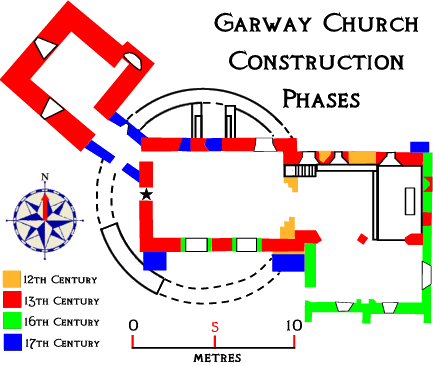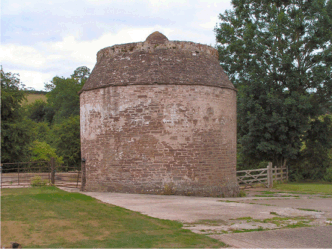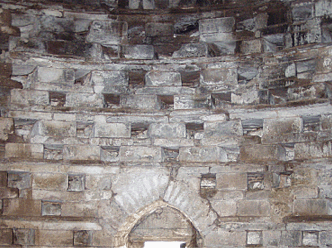


[back]
Knights of Malta
[back]
666
Garway Church dovecot
[Inside there are 666 holes..]
Just over the wall from the wall can be seen the columbarium or dovecote - see ill. 38, which was built in the time of the Templars but had fallen into disrepair by the time the Hospitallers took over, this is confirmed in an account of the property written by John-de-la-Haye in 1313. Although very feint now, there is a Latin inscription over the door which in The Gentleman's Magazine of 1907, p.635, the Reverend John Webb stated read in abbreviated form:
The full version is, " Anno Domini millesimo trecentesimo vicesimo sexto factum fuit istud columbare fratrem Ricardum", which in translation reads, "In the year of our Lord 1326 this dovecote was built by Richard", - see ill. 39, this is thought to be somewhat of an exaggeration and probably means that he repaired the dovecote in 1326. John Webb also remarks that on his visit he also noticed another inscription in the interior of the dovecote which read, "GILBE RTVS", whoever Gilbertus was remains a mystery, perhaps he helped Brother Richard in the restoration of the building? Webb describes other stones carved with, "the double cross of the Templars, accompanied in one instance with the letter R, of the scriptorial form". The upper part of the roof is 'dished' which allowed rainwater to feed through an opening into a round cistern on the floor, this then supplied the pigeons with drinking and washing water, Bond, 2004, p.151. Inside there are 20 tiers each consisting of 33 nesting holes which gives a total of 666 holes http://www.legendarydartmoor.co.uk/gar_way.htm



 The Knights Templar were given land in Llangarewi
by King Henry II in 1180. These warrior monks immediately rebuilt the Saxo-Celtic
Church in the usual circular nave and square chancel style, imitating the Church
of the Holy Sepulchre in Jerusalem. The chancel survives but the circular nave
has only been revealed through excavation. The once detached fortress-like tower
was later built as a place of safety during Welsh border raids. The Knights had
their Commandery on the site of the present Church Farm and the income from this
Manor helped pay for many Crusading campaigns in the Holy Land. The place was so
important that it even gained a visit from the Order's Grand master, James de
Molay, in 1294.
The Knights Templar were given land in Llangarewi
by King Henry II in 1180. These warrior monks immediately rebuilt the Saxo-Celtic
Church in the usual circular nave and square chancel style, imitating the Church
of the Holy Sepulchre in Jerusalem. The chancel survives but the circular nave
has only been revealed through excavation. The once detached fortress-like tower
was later built as a place of safety during Welsh border raids. The Knights had
their Commandery on the site of the present Church Farm and the income from this
Manor helped pay for many Crusading campaigns in the Holy Land. The place was so
important that it even gained a visit from the Order's Grand master, James de
Molay, in 1294.
By 1308, however, the Templars had been suppressed and Garway was given to the associated Order of Knights Hospitaller from Dinmore. Due to subsidence, they replaced the circular nave with the present one and also built the dovecote, still to be seen nearby. The Hospitallers residency was a time of hot dispute with the Bishop of Hereford from whom they claimed full independence. Things reached a head in 1523, when they refused, yet again, to pay the prelate his dues and thus found themselves excommunicated!
Garway always held the right of Sanctuary whereby criminals could find save haven in the church before fleeing abroad. However, during the Dissolution of Monmouth Priory by Henry VIII's commissioners in 1536, the last Prior, Richard Talybush fled to the sanctuary of Garway, only to find that the King's men had arrived before him and already seized all the preceptory's rights and possessions!